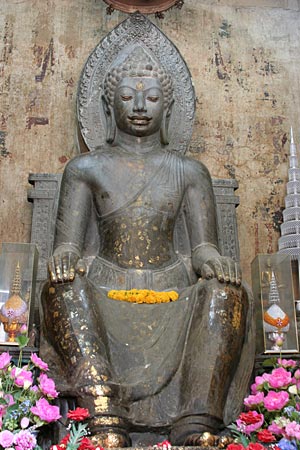Thailand Buddhism Dvaravati art Buddha Images
Discover Thailand with Thailand Discovery
Buddha Images
Thailand Buddhism Dvaravati art. Dvaravati refers to a kingdom situated in the Chao Phraya river basin between the 7th and 11th centuries A.D. Presently Dvaravati art, including many Buddha images and sculptures, can be found at National Museum in many provinces of Central Thailand, such as Phra Pathom Chedi National Museum, Nakhon Pathom, U Thong National Museum (Suphan Buri), Prachinburi National Museum. All the above mentioned National Museums are certainly worth a visit. So, initially the faces depicted would resemble Indian sculptures. Later on, influenced by local styles, the aureole would appear in a lotus bud shape or orb over the cranial protuberance. Large hair curls are visible, and the eyebrows would resemble a crows wings curve, like a flying bird. Protuding eyes, with flat nose and thick lips are common. Standing Buddha images performing the Vitarka (Preaching) posture, with robes hanging to mid shin level (see example). In sitting images, a short mantle is placed over the left shoulder. The Dharmachakra wheel (see picture at bottom) is very typical of Dvaravati art. The wheel was likely positioned on large pillars at places of worship. The Dharmachakra wheel symbolizes the Buddha’s turning of the Wheel of Truth or Law. Often the Dharmachakra has eight spokes, symbolizing the eight-fold Noble Path. The Buddha is known as the Wheel-Turner : the One who sets the cycle of teachings in motion and in consequence changes the course of destiny. Thailand Buddhism Dvaravati art
Thailand Buddhism Dvaravati art
Thailand Buddhism Dvaravati art
Thailand Buddhism Dvaravati art
Thailand Buddhism Dvaravati art
Thailand Buddhism Dvaravati art
Thailand Buddhism Dvaravati art
Thailand Buddhism Dvaravati art |
Thailand Buddhism Dvaravati art
[wp-review id=””]
